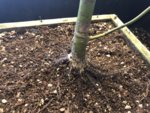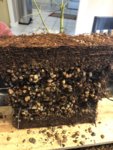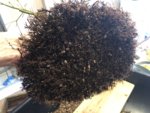Hey Frank! The cedar fencing slats sounds good. Might be able to recoup some of the wasted material
by buying inside in the lumber dept. Not being milled should save a few bucks too.
Granite Grit, is that like what you can buy for poultry at the co-op store?
Here's a couple pics of the soil I have right now. The akadama has hardened back up having dried out.
I used what I did last year while this mix was still damp out of the bucket. I've top dressed a couple
pots and didn't pay attention to the moisture content over the year. I suppose the mix is ok
and I should add maybe some granite or other aggregate. The granite grit I'm thinking of though for poultry
is crumbly when thumb nail is pressed into it but very uniform in size, mostly white.
Notice the larger 25% waste I sieved out in the 1g freezer bag.
Many particles are 1/2" and I found a 1.25" whopper nug.
Really not a bad soil, but I need to learn to make it myself and save a bit I hope
and with less waste.
The Tiny Roots Conifer has a noted increase in organics and geared down more for smaller trees.
It works in a pinch, and not bad to fill in with, later when needed i.e. after maintenance.
I'd never tried it. Saw it at a local garden years ago, decided to give it a whorl.









